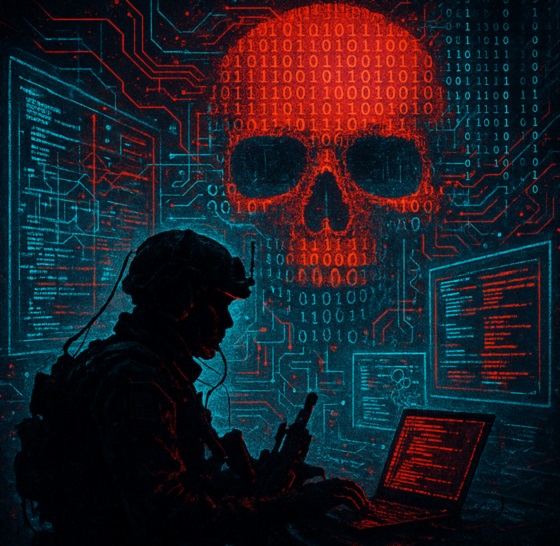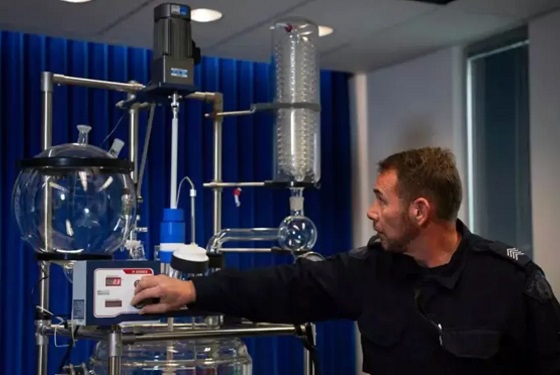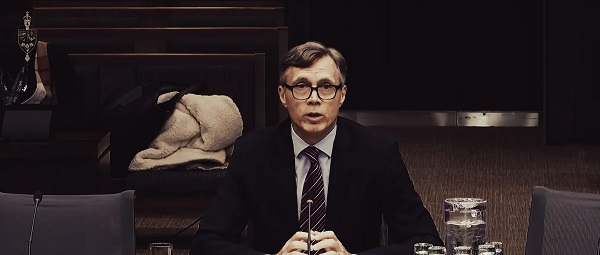Crime
Hybrid threats, broken borders, and organized chaos—transnational organized crime in Canada

By Peter Copeland & Cal Chrustie for Inside Policy
Transnational organized crime is ‘no longer just criminal,’ it’s become a geopolitical weapon, says Chrustie.
As geopolitical tensions rise and domestic vulnerabilities deepen, Canada is increasingly being used as a conduit for foreign adversaries waging hybrid warfare against the United States and its allies.
From fentanyl pipelines and money laundering to campus radicalization and weak border enforcement, a concerning picture emerges of transnational organized crime (TOC) networks operating with strategic alignment to states like China, Iran, and others.
In this edition of Inside Policy, Peter Copeland, deputy director of domestic policy at the Macdonald-Laurier Institute, sits down with Cal Chrustie, a former RCMP senior intelligence officer with deep experience in national security and transnational crime.
Chrustie tells Copeland that TOC is “no longer just criminal,” it’s become a geopolitical weapon.
“It’s about destabilizing communities, overwhelming public services, and hollowing out social cohesion,” says Chrustie.
He explains that Canada is not presently well-positioned to respond to this threat.
“Canada’s legal framework is designed for a domestic, rule-of-law environment,” he says. “It’s ill-suited to confront global adversaries who don’t play by those rules.”
Their wide-ranging conversation reveals the structural, legislative, and cultural weaknesses that have left Canada uniquely vulnerable to hybrid warfare and interconnected threats—and explores what a meaningful response might look like.
Copeland: Let’s start with fentanyl. In 2023, the U.S. Drug Enforcement Administration estimated over 70,000 fentanyl-related deaths. A growing number of precursor chemicals are sourced from China and routed through networks in Mexico and increasingly Canada. How is fentanyl trafficking being used strategically by foreign actors?
Chrustie: There’s no denying the scale of fentanyl production in Canada. It far outpaces our internal consumption. While there’s uncertainty around the volume reaching the U.S.—and certainly exaggerated claims by some Americans—we know Canadian labs are supplying Australia in large quantities. The broader concern is that we don’t know the extent of what’s crossing into the U.S. from Canada because we’re not meaningfully tracking it. That lack of visibility alone is a serious national security concern. Furthermore, the media focus has typically been China, China, China. While there are obvious signs of Chinese cartels in play, but what’s often dismissed is the role of Iranian networks.
Copeland: You touched on the issue of gaps in our understanding. At MLI, we’ve documented the minimal capacity we have at our borders—limited personnel, a very small percentage of containers and vehicles physically inspected, and mostly randomized or intelligence-led searches. Given these limitations, how can we even estimate the scale of fentanyl or other cross-border activity?
Chrustie: It’s a mistake to overly focus on the border. It’s a choke point, yes, but seizures there are often the result of intelligence generated far from the physical crossing—through complex global investigations, intelligence operations, surveillance, profiling, informants, machine learning. The U.S. has robust systems for this. Canada doesn’t. So, pointing to low seizure rates at the border as evidence of low trafficking activity is misleading and isn’t overly helpful in understanding the threat. It’s more relevant in understanding what we don’t know.
Copeland: We’ve proposed mandating more information-sharing from importers and exporters to support intelligence-based inspections. What are your thoughts on this approach?
Chrustie: Transparency helps, but you must consider the risk of compliance failure. If bad actors have infiltrated parts of the supply chain—shipping firms, port operators, truckers—then even detailed regulations won’t suffice without enforcement. Foreign state actors have the cyber capabilities to manipulate these systems too. It reinforces the need to address the problem systemically, not just tactically, and appreciate corruption and compromised systems are reality, not just a possibility.
Copeland: So, more than just piecemeal fixes?
Chrustie: Absolutely. We need a strategic, whole-of-society approach. Canada hasn’t yet conducted a serious intellectual review of why our system isn’t working. Political leaders fear what they’ll find, because it would demand systemic overhauls. These systems must take into consideration the broader threat activities and their interconnectivity with corruption, electoral interference, espionage, misinformation, and threat finance. Unfortunately, these connections are largely ignored, along with the strategic recognition that national security has a symbiotic relationship with economic security. If we were to take seriously the impact of national security on countless aspects of our social fabric—from crime, and social trust, to economic security—we would have a much more robust approach to transnational organized crime.
Copeland: Let’s take a step back. Most people probably picture transnational organized crime as gangs seeking profit, often disconnected from foreign governments. But you’ve argued that TOC is used by hostile states as a weapon in hybrid warfare. What does that mean, and how should we reframe our understanding?
Chrustie: Hybrid warfare is the blending of military and non-military means to weaken or destabilize a target. For hostile states, transnational crime is a tool—just like cyberattacks or disinformation. China, Russia, Iran, North Korea—the CRINKs—use TOC to raise money, create chaos, and undermine our institutions. TOC is no longer just criminal—it’s geopolitical.
Copeland: So the fentanyl flooding North America isn’t just a public health disaster—it’s also a weapon?
Chrustie: That’s right. It’s about destabilizing communities, overwhelming public services, and hollowing out social cohesion. Just like the Soviets used propaganda and the KGB used disinformation, modern adversaries use drugs, money laundering, and crime networks to erode their adversaries from within.
Copeland: Is Canada the main target, or are we a launchpad to attack the U.S. and our allies?
Chrustie: Both. Threat actors don’t view the Five Eyes or NATO countries in isolation—they see the alliance. So, attacks on Canada are also attacks on the U.S., Australia, the UK, and vice versa. They exploit Canada’s weaknesses, especially in places like Vancouver, where strategic assets such as ports, shipping companies and supply chain infrastructure are key hybrid warfare targets and impact the national and economic security of our allies. In the case of Vancouver, the intent is to target the US and Mexico (i.e. North America), through Vancouver-based assets as it’s a location of lower risk to operate in.
Copeland: You mentioned encrypted phone networks. Could you elaborate?
Chrustie: At one point, more encrypted communication companies linked to TOC and terrorist financers were based in Vancouver than anywhere else in the world. These platforms were used globally—by cartels, arms traffickers, terrorists, state proxies. That tells you all you need to know about how Canada is perceived by adversaries.
Copeland: What structural weaknesses are they exploiting?
Chrustie: First, we lack a national security strategy. Other countries—Australia, the U.S.—have all-of-government approaches. We don’t. Second, our institutions are siloed. Policing is on the front line, but CSIS, CBSA, military and CSE aren’t always integrated. Third, our systems—immigration, legal, financial—are outdated and easily gamed. Finally, there’s our culture: we’ve been complacent about national security.
Copeland: What does a serious strategy look like?
Chrustie: It starts with clear national priorities: identifying top threat actors (China, Iran, Russia, North Korea), coordinating agencies, aligning law enforcement and intelligence. It also means acknowledging our legal framework can’t always meet the challenge. Disruption and foreign operations—working with allies to stop threats before they reach our shores—will be critical. Also, the historical paternalist approach of governments and bureaucrats—of “we know best, and we won’t discuss these issues in public, it’s too sensitive and we are the experts,”—I think that’s dated, and China, Russia, Iran and North Korea are the biggest fans of this arrogant and naïve thinking. We need to shift immediately, engage the communities, business leaders, the legal community, and others. The solutions are in the communities, not in the siloed offices of governments.
Copeland: That raises a point about legal constraints. Are you saying our rights framework is part of the challenge?
Chrustie: Yes. Canada’s legal framework is designed for a domestic, rule-of-law environment. It’s ill-suited to confront global adversaries who don’t play by those rules. We either need carve-outs with enhanced powers for TOC-related and foreign threat activities investigations, or we need to rely more on foreign-facing disruption efforts—working abroad, with allies and accept prosecutions are secondary in measuring success. We can’t pretend that our current legal framework is workable, as the threat actors have figured this out and are taking advantage of it.
Copeland: Let’s talk about antisemitism and extremism. In the past year, we’ve seen a sharp rise on university campuses. What’s driving it?
Chrustie: Some of it is ideological, but we’re ignoring the role of transnational organized crime and foreign money. Iranian networks, for example, have long been tied to money laundering and extremist financing. These aren’t disconnected trends. The same threat actors behind fentanyl and money laundering are often involved in radicalization efforts. These are the same networks aligned to China and the Mexican cartels; they don’t operate in boxes. An old school bureaucratic lens on terrorism from the middle east, or terrorist financing analysis from a regional lens, is placing Canadians and others at risk.
Copeland: You’re suggesting that protests, radical activism, even antisemitic incidents may be downstream of the same networks enabling fentanyl and laundering billions?
Chrustie: Exactly. We’re talking about convergence. These networks exploit every vulnerability—from public health to political discourse. Failing to connect the dots between TOC, extremism, and foreign interference means we’re always reacting too late. Let’s look at the historic HSBC case, in which hundreds of millions had been laundered by the Sinaloa cartel due to lax anti-money laundering compliance by the bank, resulting in a $1.9 billion fine being levied against it. The same cartel networks that emerged through the HSBC probe are engaged in Canada today. Experts need to focus on what they don’t know versus what they think they know—look at the strategic and historical activities, accept that we are not in the middle east and accept the complexities of TOC of other activities, including terrorism and extremism.
Copeland: Lastly Calvin, I want to talk about the big picture. Evidently, Canada is seen as an easy target by our adversaries. What structural weaknesses are they exploiting?
Chrustie: This is where I think about it in four layers: strategy, structure, systems, and culture.
First, strategy. We lack a cohesive, public national security strategy. Unlike the United States or Australia, Canada doesn’t clearly define TOC as a strategic national threat. We don’t have a single, unified doctrine coordinating our federal agencies—police, intelligence, border services, foreign affairs. And without that, every department works to its own mandate, and TOC thrives in those gaps. We need to name top threat actors—China, Iran, Russia, North Korea—and make their proxies part of the strategy. We also need to shift from a policing mindset to one focused on disruption and prevention, including operations overseas.
Second, structures. Right now, the RCMP is expected to shoulder most of the burden. But that’s unsustainable. We need an all-agency model—where the Canadian Security Intelligence Service (CSIS), Canada Border Services Agency (CBSA), Financial Transactions and Reports Analysis Centre of Canada (FINTRAC), and Communications Security Establishment (CSE), the Department of Justice, Global Affairs, and others are all responsible for TOC enforcement and disruption. In the U.S., agencies are compelled to coordinate on TOC. In Canada, they’re siloed. And without a lead co-ordinating body or national TOC co-ordinator, those silos are growing.
Third, systems. Our legal system is outdated. Charter protections, disclosure rules from cases like Stinchcombe, and overly complex evidentiary requirements mean that complex cases fall apart or never get prosecuted. We also lack a dedicated foreign intelligence service like the CIA or MI6. Our immigration system is overwhelmed—there’s no way current vetting can match immigration volumes. And our financial system, particularly in real estate and casinos, has become a playground for laundered money. We need a legal and regulatory framework built for transnational threats, not 1980s-era domestic crime.
Fourth, culture. This is the most overlooked piece. Canadians are culturally indifferent to national security. We’ve taken a maternalistic approach—shielding the public from harsh realities, hoping to avoid panic or xenophobia. But that silence has allowed foreign actors to operate here with little resistance. Until we educate the public and foster a culture that values sovereignty and security, there will be no pressure to change the strategy, structure, or systems.
Copeland: Final thoughts?
Chrustie: We need to stop thinking of TOC as a law enforcement issue. It’s a military, intelligence, legal and most importantly, an all-Canada problem. There is no room for spectators. We need to stop thinking its someone isolated from all other threats and threat actors. It’s a national security crisis and its part of the slow play to weaken our political, social, and economic structures. We are years behind our allies. If we don’t get serious—strategically, structurally, and culturally—we will pay the price.
Copeland: Here’s my takeaways: In summary, we can see that Canada is uniquely vulnerable to transnational organized crime which makes it vulnerable for the broader foreign threats. Our agencies are siloed, and we lack a comprehensive strategy to effectively address issues like drug and human trafficking, to the presence of radicalization and extremism on our campuses. What’s more, our legal framework is such that we don’t have the same kinds of tools as our allies, that allows law enforcement, military, and intelligence agencies to act swiftly where issues of national security are in play.
Peter Copeland is deputy director of domestic policy at the Macdonald-Laurier Institute.
Cal Chrustie is a former RCMP senior intelligence officer with deep experience in national security and transnational crime.
Crime
Pierre Poilievre says Christians may be ‘number one’ target of hate violence in Canada

From LifeSiteNews
Anti-Christian hate crimes are not properly documented in Canada, but media reports indicate a continuing wave of violence against churches.
Conservative leader Pierre Poilievre said Monday that Christians may be the “number one” target of hate crimes when asked how he would combat the eruption of attacks on churches in Canada.
“One hundred churches have been burned,” Poilievre said, according to a CBC News report. “Christians may be the number one group that is victims of hate-based violence. But, of course, it’s not politically correct to say that.”
“This anti-Christian hate has got to stop,” said Poilievre, referring to the arson crimes as “terrorist attacks.”
Catholic and Christian churches have seen a spike in arson attacks after a public narrative that Catholic priests had murdered children said to have been found in unmarked graves at the site of Canadian indigenous residential schools run by both the Catholic Church and other Christian churches.
The attacks have reached epidemic proportions. Last week, All Saints Ukrainian Orthodox Church, northeast of Edmonton, was destroyed after being set ablaze by a 23-year-old and a 26-year-old from Saddle Lake First Nation.
At least four other churches in Canada have been set afire this year, according to media reports, including a Catholic church in Saskatchewan, a joint Anglican-Lutheran church in Manitoba, a Greek Orthodox church that had been set afire three other times in recent years, and a Salvation Army church in Newfoundland.
Catholic churches in particular have seen a big spike in violence as compared with previous years, with a jump from 43 police-reported anti-Catholic crimes in 2020 to 155 in 2021, according to Statistics Canada data.
However, hard data on the incidence of overall anti-Christian attacks in Canada is not yet available because the currently cited data on anti-religion hate crimes in Canada does not account for non-Catholic Christian churches.
In recognition of this vacuum, the Evangelical Fellowship of Canada is planning to launch an anti-Christian hate crime tracker.
Poilievre ripped liberals for enabling the rash of church attacks, calling out their policies of reduced penalties for arson, their redirection of resources from police and border services to targeting farmers and hunters, and their “divisive” identity politics.
He said he would take the “opposite approach” if elected prime minister, including “tougher laws” for hate crime perpetrators and redirecting resources away from targeting “sportshooters” and toward police services.
“Because frankly, Canadians of all faiths, including Christians, deserve to worship in peace,” he said.
Crime
The “Strong Borders Act,” Misses the Mark — Only Deep Legal Reforms Will Confront Canada’s Fentanyl Networks

The fallout is a grim roll call of major investigations that collapsed before trial in British Columbia, Alberta, Ontario, and Quebec: Project E-Pirate, E-Nationalize, Syndicato, Cobra, Brisa, and Endgame all aborted.
Bill C-2, Ottawa’s so-called “Strong Borders Act,” promises to secure Canada’s frontiers with new surveillance powers, sweeping ministerial discretion, and higher penalties. But as veteran Canadian investigators know, the bill misses the point. It is an omnibus solution that expands the state’s reach online, while leaving untouched the very legal choke points that have made Canada a permissive financial platform and fentanyl laboratory for cartels, Triads, and state-linked terror networks.
For more than a decade, Canadian and U.S. enforcement leaders have pointed to the same failures. Police are confronting transnational fentanyl labs, a flood of Chinese chemical precursors, Hezbollah-linked laundering, and Mexican cartels setting up on Canadian soil.
Yet they are forced to fight these threats with laws “never designed for today’s criminal landscape,” as Canadian Chiefs of Police president Thomas Carrique recently warned.
Former RCMP investigator Calvin Chrustie testified before British Columbia’s Cullen Commission that, due to judicial blockages arising from Charter of Rights rulings, by 2015 it had become effectively impossible to obtain wiretaps on Sinaloa Cartel figures in Vancouver.
This year, RCMP Assistant Commissioner David Teboul said a proliferation of “commercial-grade chemistry” fentanyl labs in British Columbia — like the sophisticated factory dismantled last year in Falkland, north of Lake Okanagan, where Mexican cartels have quietly taken over domestic biker gang networks — underlined the urgent need for legislative reform.
Canada wasn’t always so overwhelmed by lethal foreign gangs. What happened? Overly permissive immigration rules and porous borders explain part of the story, but the deeper problem lies in the laws that have steadily eroded enforcement power since the early 1990s.
Instead of enabling prosecutions against transnational traffickers of humans, narcotics, and weapons, unintended consequences from misguided jurisprudence surrounding Canada’s Charter of Rights now ensure these cases almost always collapse, or are simply avoided by the Crown.
Two Supreme Court rulings — Stinchcombe and Jordan — have gutted the capacity to prosecute complex crime. Stinchcombe requires exhaustive disclosure of sensitive intelligence, often impossible in Five Eyes investigations that depend on close cooperation between Canada and the United States.
Jordan imposes strict trial ceilings that tick down while Stinchcombe disclosure battles drag on. Criminal lawyers know these two rulings function as trump cards stacked in favor of their clients.
The fallout is a grim roll call of major investigations that collapsed before trial in British Columbia, Alberta, Ontario, and Quebec: Project E-Pirate, E-Nationalize, Syndicato, Cobra, Brisa, and Endgame all aborted. Project Collecteur — a landmark probe linking Hezbollah and foreign terror-financing networks across Canadian cities to transnational drug money laundering, built on U.S. and Australian intelligence — barely made it to court, despite its far-reaching implications.
It was crippled by RCMP corruption and by underfunded, risk-averse agencies that abandoned Canadian leads painstakingly developed by Five Eyes partners.
How bad was it?
Farzam Mehdizadeh, a major Iranian money launderer and suspected weapons proliferation actor who ran a Toronto currency exchange while shuttling bags of drug cash between Toronto and Montreal, escaped back to Iran just as the RCMP was poised to arrest him on money-laundering charges. The beneficiary of a leaky national police force, evidently.
A senior U.S. enforcement source told The Bureau that during Project Collecteur, the RCMP stumbled onto an even bigger Chinese money launderer while probing Iranian networks, but the agency ignored the file — reportedly unable to shift its original investigation focus onto new enterprise targets.
These kinds of policing failures and decisions are part of the reason President Donald Trump has said senior U.S. investigators told him that Canada lacks the resources and capacity to confront fentanyl trafficking gangs.
In Washington, there is frustration — and at times a lack of understanding — that Stinchcombe either bars or effectively scares the Mounties out of cooperating with U.S. agencies or sharing intelligence.
Derek Maltz, former DEA chief under President Trump, pointed to the Falkland fentanyl super-lab case — part of a U.S.-led probe into Chinese precursor suppliers — as the latest example of “historical issues with the RCMP not sharing properly,” calling it a “major disaster that happened on that big lab in British Columbia.”
“It goes down to the basic information sharing, the antiquated laws,” Maltz said. After meeting with current Canadian police leadership, he concluded: “They’re so far behind and the laws are so antiquated and so archaic.”
The cost is staggering. Officers walk away from enterprise files, knowing they cannot meet disclosure or trial deadlines. Prosecutors refuse to take high-risk cases. U.S. agencies stop sharing intelligence that could be exposed in open court. Canada defaults to “low-hanging fruit” prosecutions while the upper echelons of global networks operate with near impunity.
Meanwhile, at the border, permissive Non-Resident Importer rules allow foreign entities to move chemical precursors through Canadian ports under layers of corporate opacity. Chinese logistics hubs repackage bulk fentanyl shipments bound for Vancouver, obscuring Canada’s visibility into their true origin. Once in Canada, packages can be collected by foreign nationals who further conceal their identities. To visualize the scheme, think of an “end-to-end encryption” app — Chinese trafficking networks enjoy the same kind of seamless concealment when shipping narcotics into Canada.
At the same time, Vancouver’s port — stripped of federal police under Jean Chrétien’s Liberal government — has container inspection rates below one percent, according to a British Columbia study.
It doesn’t seem that Bill C-2 will do anything to address these core vulnerabilities. It gives Ottawa broad powers to expand online surveillance, which may help with the drug networks that now brazenly advertise street sales on social platforms. But it would do so by subjecting all Canadians to invasive cyber surveillance. The bill does not target the transnational criminals who are already easy to identify and well known to law enforcement. These networks continue to operate openly in Canada, confident that the Charter shields them from real prosecution.
Meanwhile, experts warn that parts of C-2 resemble Ottawa’s wish list of new powers tossed into a grab bag. The effect is the opposite of inspiring public confidence or addressing the real enforcement crisis. As written, Bill C-2 could do more harm than good. Mark Carney’s government should shelve it and start again with the reforms Canada actually needs.
The Bureau is a reader-supported publication.
To receive new posts and support my work, consider becoming a free or paid subscriber.
-

 National12 hours ago
National12 hours agoCanada’s birth rate plummets to an all-time low
-

 Agriculture1 day ago
Agriculture1 day agoCarney’s nation-building plan forgets food
-

 Fraser Institute1 day ago
Fraser Institute1 day agoAboriginal rights now more constitutionally powerful than any Charter right
-

 Alberta1 day ago
Alberta1 day agoAlberta puts pressure on the federal government’s euthanasia regime
-

 Business14 hours ago
Business14 hours agoElon Musk announces ‘Grokipedia’ project after Tucker Carlson highlights Wikipedia bias
-

 Crime12 hours ago
Crime12 hours agoPierre Poilievre says Christians may be ‘number one’ target of hate violence in Canada
-

 Red Deer1 day ago
Red Deer1 day agoThe City or Red Deer Financial Troubles: The Role of Good Governance, Effective Policies and Key Performance Metrics.
-

 Business1 day ago
Business1 day agoDemocracy Watch Drops a Bomb on Parliament Hill







